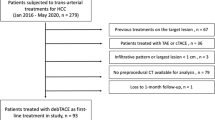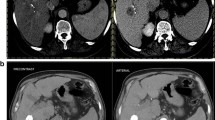Abstract
Purpose
The aim of this study was to describe changes in contrast agent kinetics in HCC following incomplete trans-arterial chemoembolization (TACE) on contrast-enhanced ultrasound (CEUS) and MRI/CT.
Methods
Patients with residual HCC proven by biopsy, retreatment angiography, or 4–8 month MRI demonstrating tumor progression were identified. Pre-treatment and 4–6-week follow-up CE-MRI/CT and CEUS exams were collected for blinded reads by two experienced readers for each modality to evaluate arterial phase hyper-enhancement (APHE) and washout within the residual HCC. A third reader provided tie-breaking decisions for any disagreements.
Results
Contrast-enhanced imaging data were collected from 29 patients with residual HCC post-TACE. On CEUS, 84.2% of patients with baseline APHE demonstrated APHE post-TACE (p = 0.25). On CE-MRI/CT, 57.1% of patients with baseline APHE later demonstrated APHE (p = 0.004). As for washout, on CEUS 33.3% of patients with baseline washout retained washout post-TACE (p = 0.01), while on CE-MRI/CT only 18.8% of patients with baseline washout later demonstrated washout (p < 0.001). Among CEUS readers, reader agreement was 100% for baseline APHE, 66.7% for baseline washout (K = 0.35), 84.2% for post-TACE APHE (K = 0.35), and 57.9% for post-TACE washout (K = − 0.09). On CE-MRI/CT, reader agreement was 65.5% for baseline APHE (K = 0.19), 55.2% for baseline washout (K = 0.12), 48.3% for post-TACE APHE (K = − 0.07), and 58.6% for post-TACE washout (K = 0.04).
Conclusion
Common diagnostic features of treatment-naïve HCC like APHE and washout can be substantially altered by TACE and should be considered when diagnosing residual disease on contrast-enhanced imaging.




Similar content being viewed by others
Data availability
Not applicable.
Code availability
Not applicable.
Abbreviations
- HCC:
-
Hepatocellular carcinoma
- BCLC:
-
Barcelona Clinic Liver Cancer
- TACE:
-
Trans-arterial chemoembolization
- c-TACE:
-
Conventional TACE
- DEB-TACE:
-
Drug-eluting bead TACE
- CE-MRI:
-
Contrast-enhanced magnetic resonance imaging
- CT:
-
Computed tomography
- CEUS:
-
Contrast-enhanced ultrasound
- APHE:
-
Arterial phase hyper-enhancement
- LI-RADS:
-
Liver Imaging Reporting and Data System
- IRB:
-
Institutional review board
- MI:
-
Mechanical index
- SSFSE:
-
Single-shot fast spin echo
- THRIVE:
-
T1 high-resolution isotropic volume examination
- SD:
-
Standard deviation
- IQR:
-
Inter-quartile range
References
McGlynn KA, Petrick JL, El‐Serag HB. Epidemiology of Hepatocellular Carcinoma. Hepatology. 2021;73(S1):4-13. doi:https://doi.org/https://doi.org/10.1002/hep.31288
Rawla P, Sunkara T, Muralidharan P, Raj JP. Update in global trends and aetiology of hepatocellular carcinoma. Contemp Oncol. 2018;22(3):141-150. doi:https://doi.org/10.5114/wo.2018.78941
El-Serag HB, Marrero JA, Rudolph L, Reddy KR. Diagnosis and Treatment of Hepatocellular Carcinoma. Gastroenterology. 2008;134(6):1752-1763. doi:https://doi.org/10.1053/j.gastro.2008.02.090
Makary MS, Khandpur U, Cloyd JM, Mumtaz K, Dowell JD. Locoregional Therapy Approaches for Hepatocellular Carcinoma: Recent Advances and Management Strategies. Cancers. 2020;12(7). doi:https://doi.org/10.3390/cancers12071914
Heckman JT, deVera MB, Marsh JW, et al. Bridging Locoregional Therapy for Hepatocellular Carcinoma Prior to Liver Transplantation. Ann Surg Oncol. 2008;15(11):3169-3177. doi:https://doi.org/10.1245/s10434-008-0071-3
Forner A, Reig ME, Lope CR de, Bruix J. Current Strategy for Staging and Treatment: The BCLC Update and Future Prospects. Semin Liver Dis. 2010;30(1):61-74. doi:https://doi.org/10.1055/s-0030-1247133
Huo T-I. Locoregional Therapy. In: Schwab M, ed. Encyclopedia of Cancer. Springer, Berlin, Heidelberg; 2011:2072-2073. doi:https://doi.org/10.1007/978-3-642-16483-5_3407
Varela M, Real MI, Burrel M, et al. Chemoembolization of hepatocellular carcinoma with drug eluting beads: Efficacy and doxorubicin pharmacokinetics. J Hepatol. 2007;46(3):474-481. doi:https://doi.org/10.1016/j.jhep.2006.10.020
Sciarra A, Ronot M, Tommaso LD, et al. TRIP: a pathological score for transarterial chemoembolization resistance individualized prediction in hepatocellular carcinoma. Liver Int. 2015;35(11):2466-2473. doi:https://doi.org/https://doi.org/10.1111/liv.12844
Tsurusaki M, Murakami T. Surgical and Locoregional Therapy of HCC: TACE. Liver Cancer. 2015;4(3):165-175. doi:https://doi.org/10.1159/000367739
Burrel M, Reig M, Forner A, et al. Survival of patients with hepatocellular carcinoma treated by transarterial chemoembolisation (TACE) using Drug Eluting Beads. Implications for clinical practice and trial design. J Hepatol. 2012;56(6):1330-1335. doi:https://doi.org/10.1016/j.jhep.2012.01.008
Nam K, Stanczak M, Lyshchik A, et al. Evaluation of Hepatocellular Carcinoma Transarterial Chemoembolization using Quantitative Analysis of 2D and 3D Real-time Contrast Enhanced Ultrasound. Biomed Phys Eng Express. 2018;4(3):035039. doi:https://doi.org/10.1088/2057-1976/aabb14
Gaba RC, Lokken P, Hickey R, et al. Quality Improvement Guidelines for Transarterial Chemoembolization and Embolization of Hepatic Malignancy. 2017;28(9):17.
Kono Y, Lucidarme O, Choi S-H, et al. Contrast-enhanced Ultrasound as a Predictor of Treatment Efficacy within 2 Weeks after Transarterial Chemoembolization of Hepatocellular Carcinoma. J Vasc Interv Radiol. 2007;18(1):57-65. doi:https://doi.org/10.1016/j.jvir.2006.10.016
Wessner CE, Shaw CM, Stanczak M, et al. Contrast-enhanced Ultrasound Identifies Patent Feeding Vessels in Transarterial Chemoembolization Patients With Residual Tumor Vascularity. Ultrasound Q. 2020;36(3):218-223. doi:https://doi.org/10.1097/RUQ.0000000000000513
Claudon M, Cosgrove D, Albrecht T, et al. Guidelines and Good Clinical Practice Recommendations for Contrast Enhanced Ultrasound (CEUS) - Update 2008. Ultraschall Med - Eur J Ultrasound. 2008;29(01):28-44. doi:https://doi.org/10.1055/s-2007-963785
Wilson SR, Greenbaum LD, Goldberg BB. Contrast-Enhanced Ultrasound: What Is the Evidence and What Are the Obstacles? Am J Roentgenol. 2009;193(1):55-60. doi:https://doi.org/10.2214/AJR.09.2553
Tang A, Bashir MR, Corwin MT, et al. Evidence Supporting LI-RADS Major Features for CT- and MR Imaging–based Diagnosis of Hepatocellular Carcinoma: A Systematic Review. Radiology. 2017;286(1):29-48. doi:https://doi.org/10.1148/radiol.2017170554
Yang HK, Burns PN, Jang H-J, et al. Contrast-enhanced ultrasound approach to the diagnosis of focal liver lesions: the importance of washout. Ultrasonography. 2019;38(4):289-301. doi:https://doi.org/10.14366/usg.19006
American College of Radiology Committee on LI-RADS. CEUS LI-RADS v2017. Accessed April 14, 2021. https://www.acr.org/Clinical-Resources/Reporting-and-Data-Systems/LI-RADS/CEUS-LI-RADS-v2017.
Goldberg SN, Grassi CJ, Cardella JF, et al. Image-guided Tumor Ablation: Standardization of Terminology and Reporting Criteria. J Vasc Interv Radiol. 2009;20(7, Supplement):S377-S390. doi:https://doi.org/10.1016/j.jvir.2009.04.011
American College of Radiology Committee on LI-RADS. MRI/CT LI-RADS v2017. Accessed April 14, 2021. https://www.acr.org/Clinical-Resources/Reporting-and-Data-Systems/LI-RADS/CT-MRI-LI-RADS-v2018.
Shaw CM, Eisenbrey JR, Lyshchik A, et al. Contrast-Enhanced Ultrasound Evaluation of Residual Blood Flow to Hepatocellular Carcinoma After Treatment With Transarterial Chemoembolization Using Drug-Eluting Beads. J Ultrasound Med. 2015;34(5):859-867. doi:https://doi.org/https://doi.org/10.7863/ultra.34.5.859
Lekht I, Gulati M, Nayyar M, et al. Role of contrast-enhanced ultrasound (CEUS) in evaluation of thermal ablation zone. Abdom Radiol. 2016;41(8):1511-1521. doi:https://doi.org/10.1007/s00261-016-0700-4
Jang H-J, Kim TK, Burns PN, Wilson SR. CEUS: An essential component in a multimodality approach to small nodules in patients at high-risk for hepatocellular carcinoma. Eur J Radiol. 2015;84(9):1623-1635. doi:https://doi.org/10.1016/j.ejrad.2015.05.020
Acknowledgements
Contrast-enhanced ultrasound data were obtained from an ongoing clinical trial (NCT#02764801) which received ultrasound contrast agent from Lantheus Medical Imaging (N. Billerica, MA) and equipment support from GE Healthcare (Milwaukee, WI).
Funding
Research funding was provided by NIH R01 CA194307 and NIH R01 CA215520.
Author information
Authors and Affiliations
Corresponding author
Ethics declarations
Conflict of interest
CEW declares that he is a consultant in Bracco Imaging. AL declares that he is a research supporter in GE Healthcare, Bracco Diagnostics, Siemens Healthineers, and Canon Medical Systems, is a member of advisory board in Bracco Diagnostics, is a consultant in GE Healthcare, Bioclinica, and WorldCare Clinical, and is one of the members of speaker panel in GE Healthcare, and has book royalties in Elsevier. JRE received grant and equipment support from GE Healthcare, equipment support from Siemens, and drug support and speaker honorarium from Lantheus Medical Imaging. All other authors have no conflict of interest to declare.
Ethical approval
This study was approved by the university’s Institutional Review Board.
Consent to participate
All patients in this trial provided informed consent to participate in the initial contrast-enhanced ultrasound study.
Consent for publication
Consent to publish de-identified images and data were included in the informed consent process.
Additional information
Publisher's Note
Springer Nature remains neutral with regard to jurisdictional claims in published maps and institutional affiliations.
Rights and permissions
About this article
Cite this article
Polikoff, A., Wessner, C.E., Balasubramanya, R. et al. Imaging appearance of residual HCC following incomplete trans-arterial chemoembolization on contrast-enhanced imaging. Abdom Radiol 47, 152–160 (2022). https://doi.org/10.1007/s00261-021-03298-z
Received:
Revised:
Accepted:
Published:
Issue Date:
DOI: https://doi.org/10.1007/s00261-021-03298-z




